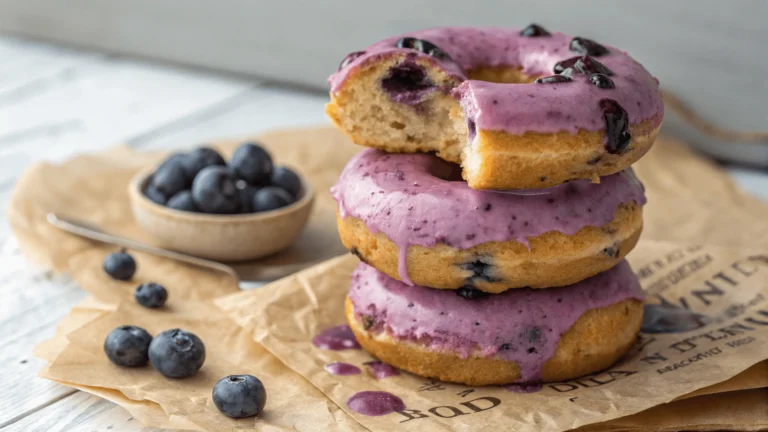Heavenly Bites: Discover the Magic of Chocolate Truffle Cake
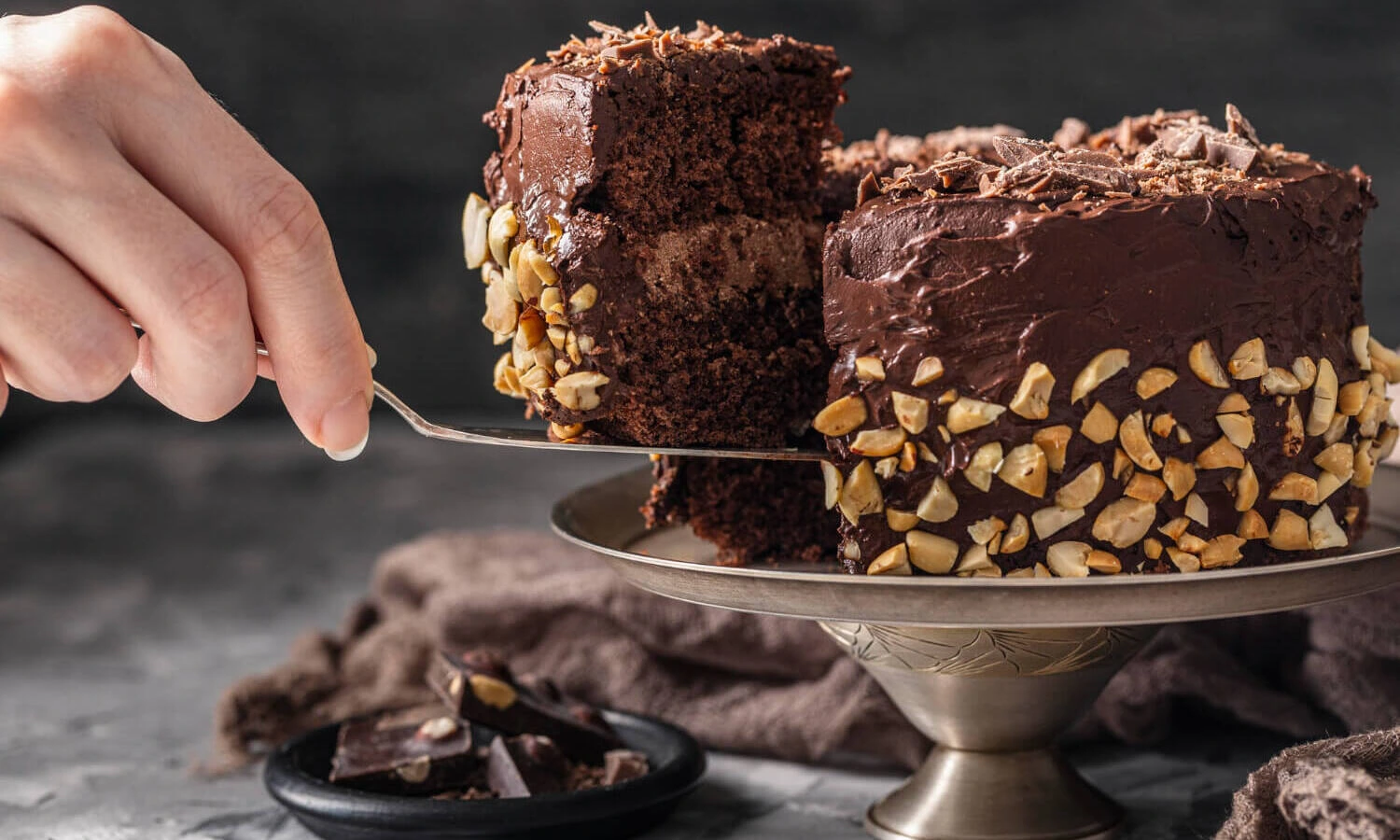
There’s something undeniably enchanting about the first bite of a perfectly crafted chocolate truffle cake—the way it melts on your tongue, releasing waves of rich, complex cocoa flavor that dance across your palate. Unlike ordinary chocolate desserts, a truffle cake exists in that magical space between cake and confection, offering an experience that’s simultaneously familiar and extraordinary.
In this culinary journey, we’ll unlock the secrets behind creating the ultimate chocolate truffle cake—a dark chocolate dessert that impresses with its sophisticated flavor profile and velvety texture. Whether you’re a seasoned baker looking to perfect your chocolate cake recipe or simply a dessert enthusiast searching for chocolate dessert ideas that elevate your entertaining game, this guide delivers everything you need to create this show-stopping treat.
Get ready to discover why chocolate truffle cake deserves its reputation as the crown jewel of chocolate desserts—a decadent indulgence that transforms ordinary moments into celebrations.
Essential Ingredients for the Ultimate Chocolate Truffle Cake
Selecting the Perfect Chocolate
The foundation of an exceptional chocolate truffle cake begins with selecting the right chocolate. For authentic truffle cake flavor, look for dark chocolate with 65-70% cocoa content. This range offers the perfect balance—chocolatey enough to deliver complexity while still maintaining approachable sweetness.
When shopping, choose chocolate specifically designed for baking rather than eating chocolate, as it melts more consistently. Brands like Valrhona, Ghirardelli, or Callebaut offer excellent options for serious bakers, though Lindt Excellence bars provide a more accessible alternative that still delivers impressive results.
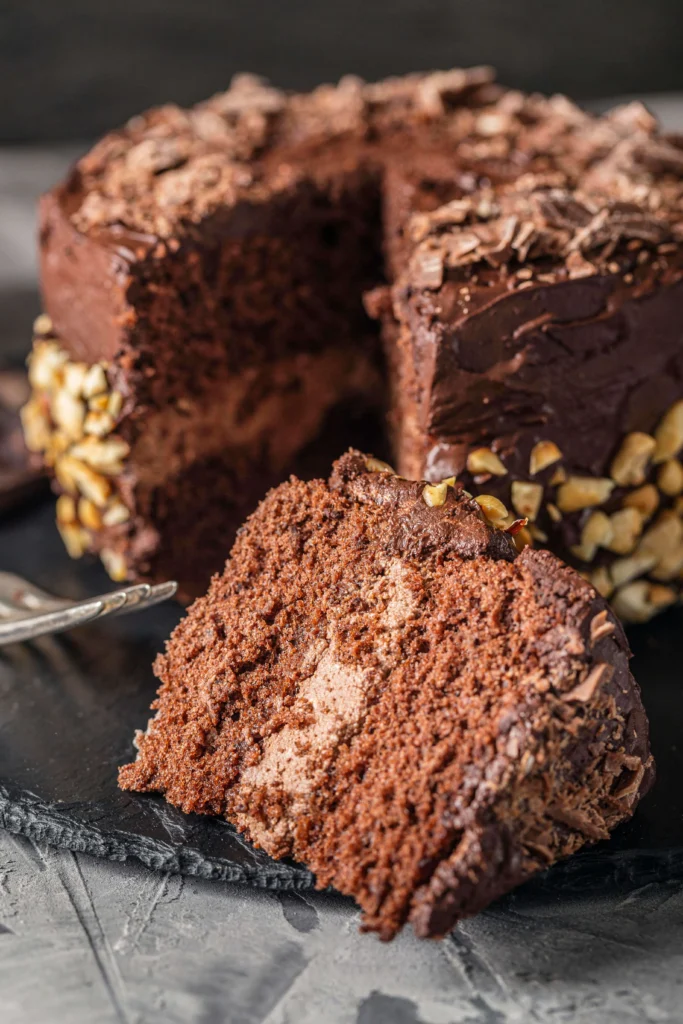
The chocolate’s origin also influences flavor notes. Single-origin chocolates from Madagascar often feature fruity undertones, while Venezuelan varieties typically offer nutty, caramel notes. For a classic truffle cake, consider blending chocolates from different origins to create a more balanced and complex profile.
Step-by-Step Chocolate Truffle Cake Recipe
Preparation Tips Before You Begin
Before diving into your chocolate truffle cake creation, proper preparation ensures the best results:
Equipment needs are relatively simple—you’ll need an 8-inch springform pan (the removable sides make extraction much easier), parchment paper, a reliable mixing bowl, and a good whisk or electric mixer. A double boiler setup (or a heat-proof bowl set over simmering water) is essential for properly melting chocolate without scorching.
Ingredient preparation is crucial: remove butter and eggs from the refrigerator at least two hours before beginning to ensure they reach room temperature. Measure all ingredients before starting, and sift dry ingredients together to eliminate lumps and ensure even distribution.
Time management tip: The cake requires cooling completely before the ganache application, so consider baking the cake base a day ahead. This not only divides the workload but actually improves flavor as the chocolate notes develop overnight.
The Foolproof Baking Method
Follow these steps precisely for chocolate truffle cake success:
- Preheat your oven to 325°F (165°C)—lower than typical cake recipes to prevent the chocolate from drying out. Line your springform pan with parchment paper and lightly grease the sides.
- In your double boiler, gently melt the chocolate and butter together, stirring occasionally until completely smooth. The mixture should feel warm but not hot. Remove from heat and let cool slightly.
- In a separate bowl, whisk together eggs and sugar until pale and slightly thickened—about 3-4 minutes with an electric mixer. The mixture should form ribbons when the whisk is lifted.
- Slowly pour the chocolate mixture into the egg mixture while continuously whisking. This gradual incorporation prevents the eggs from cooking on contact with warm chocolate.
- Gently fold in the sifted flour, cocoa powder, and salt just until combined. Overmixing at this stage develops gluten, which would toughen your cake.
- Pour batter into the prepared pan and bake for 30-35 minutes. The cake is done when the edges are set but the center still has a slight wobble—it will continue cooking from residual heat.
- Allow to cool completely in the pan before releasing the sides and finishing with ganache.
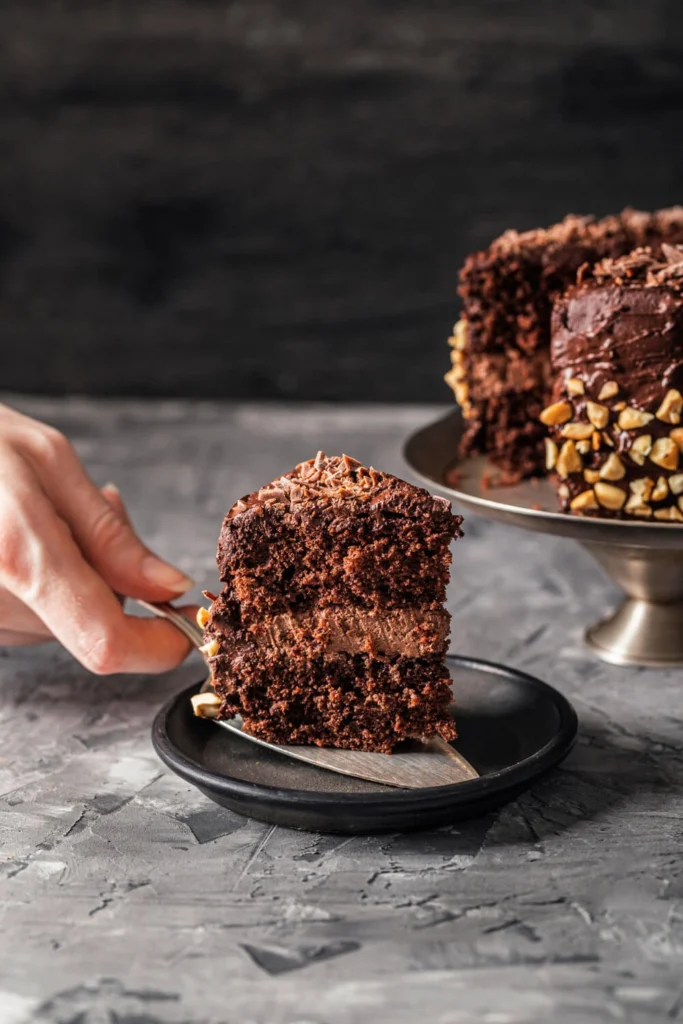
Watch for visual cues rather than strictly adhering to timing—the cake should pull away slightly from the pan edges, and a toothpick inserted 1 inch from the edge should come out mostly clean with a few moist crumbs.
| Ingredients | Quantity |
|---|---|
| Dark chocolate (70% cocoa) | 200g |
| Unsalted butter | 175g |
| Granulated sugar | 150g |
| Eggs | 4 large |
| All-purpose flour | 75g |
| Cocoa powder | 25g |
| Salt | 1/4 tsp |
| Heavy cream | 120ml |
| Dark chocolate chips | 150g |
For the ganache topping:
- Heat cream until just simmering (not boiling)
- Pour over chocolate chips in a heat-proof bowl
- Let sit for 2 minutes, then stir until smooth
- Pour over cooled cake and spread evenly
- Refrigerate for at least 1 hour before serving
Expert Tips for Chocolate Dessert Perfection
Troubleshooting Common Issues
Even experienced bakers encounter challenges with chocolate truffle cake. Here’s how to address the most common problems:
Dry cake typically results from overbaking. Remember that truffle cake should retain moisture—it’s better to slightly underbake than overbake. If your cake turns out dry, brush the layers with a simple syrup (equal parts sugar and water, simmered until dissolved) before applying ganache.
Sunken centers often occur from opening the oven door too early in the baking process or from sudden temperature changes. The cake needs gentle, consistent heat. If your cake sinks, embrace it—a slightly sunken center creates the perfect reservoir for extra ganache or complementary fillings like raspberry coulis.
Ganache problems typically stem from incorrect temperature ratios. If your ganache separates or appears grainy, gently warm it while whisking vigorously, or add a teaspoon of warm cream and blend until smooth. For ganache that’s too runny, refrigerate for 10-minute intervals, stirring between each until it reaches spreading consistency.
Decorating Your Chocolate Masterpiece
The beauty of chocolate truffle cake lies in its elegant simplicity, but thoughtful decoration elevates it further:
For simple yet sophisticated decoration, dust the ganache with high-quality cocoa powder using a fine-mesh sieve, or add chocolate curls created by dragging a vegetable peeler along a slightly warmed chocolate bar.
Seasonal variations keep your truffle cake fresh and interesting throughout the year. Summer calls for fresh berries arranged in a simple pattern, while autumn might feature candied orange peel or sugared cranberries. Winter celebrations benefit from gold leaf accents or a sprinkle of edible glitter.
For special occasions, consider professional-level touches like chocolate transfer sheets for patterned designs on ganache, or tempered chocolate decorations. Even a simple chocolate fan or curved piece positioned artfully on top transforms homemade into restaurant-quality presentation.
- Allow ingredients to reach room temperature before beginning
- Use a double boiler to melt chocolate gently
- Fold ingredients carefully to maintain air in the batter
- Test doneness with a toothpick inserted in the center
- Cool completely before adding ganache
- Refrigerate for at least 2 hours before serving
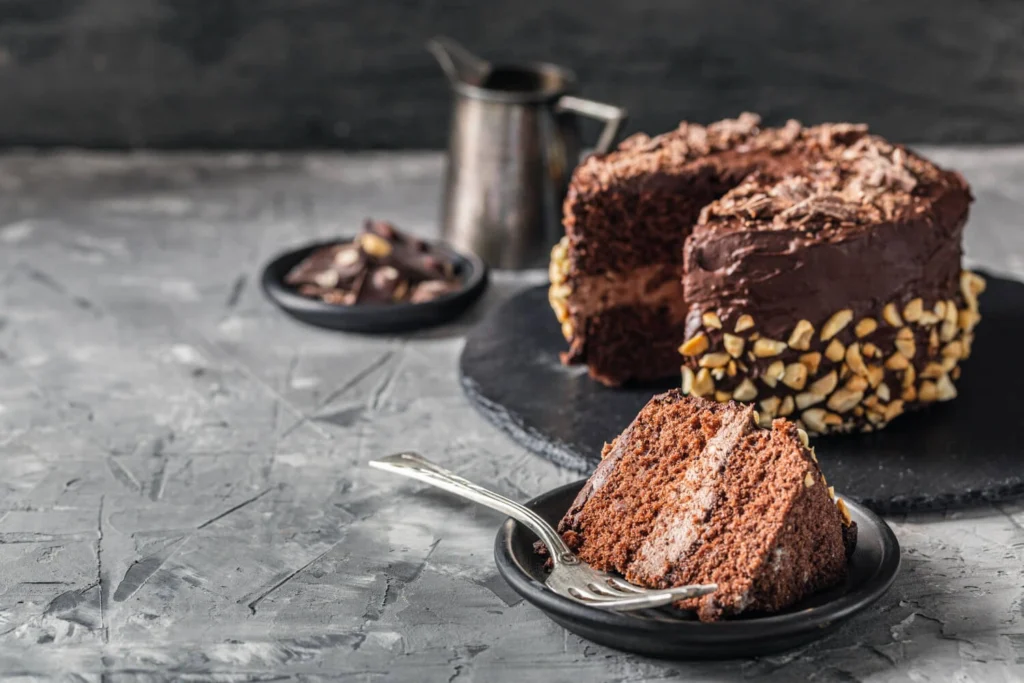
Chocolate Cake Variations to Explore
Flavor Enhancements
Once you’ve mastered the basic chocolate truffle cake recipe, experiment with these sophisticated flavor variations:
Coffee intensifies chocolate’s natural flavor without adding perceptible coffee taste. Add 1-2 tablespoons of espresso powder to your dry ingredients, or replace some of the liquid in your ganache with strongly brewed espresso for a mocha variation that enhances the chocolate experience.
Liqueurs open up endless possibilities. For a sophisticated orange chocolate combination, add 2 tablespoons of Grand Marnier and 1 tablespoon of orange zest to your batter. Raspberry liqueur creates a fruit-forward variation, while Frangelico introduces lovely hazelnut notes that complement chocolate’s natural flavor profile.
Spice combinations can transform your chocolate truffle cake. A Mexican-inspired variation might include 1 teaspoon of cinnamon, a pinch of cayenne, and a dash of vanilla. For holiday gatherings, consider incorporating warming spices like cardamom, nutmeg, and clove—just 1/4 teaspoon of each creates a subtle complexity that guests will notice without overpowering the chocolate.
Dietary Adaptations
Modern dietary needs shouldn’t prevent anyone from enjoying chocolate truffle cake:
For gluten-free versions, substitute all-purpose flour with a high-quality cup-for-cup gluten-free flour blend. Because truffle cake uses minimal flour and doesn’t rely on gluten development, this substitution works particularly well without compromising texture or flavor.
Dairy-free alternatives can produce excellent results. Replace butter with coconut oil (use 25% less than the butter amount) and substitute coconut cream for heavy cream in the ganache. Select dairy-free dark chocolate, confirming it contains no milk solids.
Reduced sugar options maintain decadence while decreasing overall sweetness. Reduce sugar by 25% without other adjustments, or experiment with alternatives like coconut sugar or monk fruit sweetener (though these will slightly alter flavor profiles). The high chocolate content means the cake remains delicious even with reduced sweetness.
- Espresso Truffle Cake: Add 1 tbsp espresso powder to the batter
- Orange Zest Truffle Cake: Incorporate 1 tbsp orange zest and 2 tbsp orange liqueur
- Raspberry Truffle Cake: Layer with raspberry preserves between cake layers
- Hazelnut Truffle Cake: Add 50g ground hazelnuts and 2 tbsp Frangelico
Serving and Storage Information
Nutritional Information and Portion Control
Understanding the nutritional profile of chocolate truffle cake helps you enjoy this indulgence mindfully:
A standard slice (1/12 of an 8-inch cake) typically contains approximately 320-375 calories, with 22g fat, 33g carbohydrates, and 4g protein. The dark chocolate contributes beneficial antioxidants, particularly flavanols, which studies suggest may support cardiovascular health in moderate consumption.
For healthier serving suggestions, consider smaller portions paired with fresh fruit like strawberries or raspberries, which complement the chocolate flavor while adding nutritional value and visual appeal.
Portion size recommendations for chocolate truffle cake lean toward moderation—this rich dessert satisfies even in small amounts. Consider cutting your cake into 12-16 slices rather than the standard 8-10, allowing guests to enjoy its decadence without overindulging.
Freezing and Storing Your Chocolate Cake
Proper storage extends your chocolate truffle cake’s life and preserves its quality:
For refrigerator storage, cover the cake with a cake dome or loosely tent with foil to prevent absorbing refrigerator odors. The cake will maintain optimal quality for up to 5 days refrigerated, though the texture is best within the first 3 days.
Freezing chocolate truffle cake works remarkably well, actually preserving its fudgy texture. For best results, freeze the cake without ganache, adding it after thawing. Wrap individual slices or the whole cake (without ganache) in plastic wrap, then aluminum foil, and place in a freezer bag with air removed.
When ready to serve from frozen, thaw overnight in the refrigerator rather than at room temperature. This slow thaw preserves texture and prevents condensation that could make the cake soggy. Once thawed, allow the cake to sit at room temperature for 30 minutes before serving for optimal flavor release.
- Cool cake completely before storing
- Wrap tightly in plastic wrap, then aluminum foil
- Store in refrigerator for up to 5 days
- Freeze for up to 3 months
- Thaw overnight in refrigerator before serving
Conclusion
Chocolate truffle cake stands as testament to chocolate’s transformative power—turning simple ingredients into something altogether luxurious and memorable. This dense, fudgy creation occupies the sweet spot between cake and confection, delivering chocolate intensity that satisfies deeply without overwhelming the palate.
We’ve journeyed through the essential elements that make chocolate truffle cake special—from selecting quality dark chocolate to mastering techniques that ensure that signature texture. We’ve explored variations that personalize this classic while maintaining its soul, and discovered perfect pairings that elevate the experience further.
We’d love to hear about your chocolate truffle cake adventures! Share your experiences, variations, and serving suggestions in the comments below.
Chocolate truffle cake FAQ
Can I make chocolate truffle cake ahead of time?
Yes! It often tastes better the day after baking as flavors develop. Bake up to three days ahead, refrigerate, and add ganache the day before serving.
What’s the difference between chocolate truffle cake and regular chocolate cake?
Truffle cake uses less flour and more chocolate for a denser, fudgier texture. It typically features darker chocolate for more intense flavor and has a lower profile than regular chocolate cake.
Can I use milk chocolate instead of dark chocolate?
You can, but expect a sweeter cake with less pronounced chocolate flavor. Reduce sugar by 25% and anticipate a softer texture requiring longer refrigeration. A 50/50 mix offers a good compromise.
How do I know when my chocolate truffle cake is done baking?
Edges should pull away from the pan and appear set while the center retains slight moisture. A toothpick inserted 1-inch from the edge should have a few moist crumbs. Some center softness is desirable for that truffle-like texture.
Why did my cake sink in the middle?
Some sinking is normal and creates a natural well for ganache. Excessive sinking may result from opening the oven door too early, overmixing, or temperature issues. Convert dramatic sinking into a design feature by filling with whipped cream or fruit.
Can I make this recipe as cupcakes instead?
Yes! Fill lined muffin tins 2/3 full and bake 15-18 minutes. For the complete truffle effect, core each cooled cupcake and fill with ganache before topping. Expect 12-14 cupcakes from the standard recipe.

